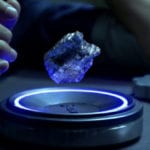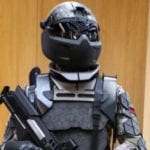 Movies and TV
Movies and TV  Movies and TV
Movies and TV  Humans
Humans 10 Times Scientists Were Absolutely Sure… and Absolutely Wrong
 Our World
Our World 10 Pivotal Moments for Life on Earth
 Movies and TV
Movies and TV 10 Most Realistic Medical TV Shows of All Time
 Creepy
Creepy 10 Eerie & Mysterious Ghosts of the Pacific Coast
 Weird Stuff
Weird Stuff 10 Typos That Accidentally Changed History
 History
History 10 Times Trickery Won Battles
 Technology
Technology 10 Awesome Upgrades to Common Household Items
 Misconceptions
Misconceptions 10 Hilarious (and Totally Wrong) Misconceptions About Childbirth
 Weird Stuff
Weird Stuff 10 Warning Labels That Exist Because Someone Actually Tried It
 Movies and TV
Movies and TV 10 Zombie Movies That Will Actually Terrify You
 Humans
Humans 10 Times Scientists Were Absolutely Sure… and Absolutely Wrong
 Our World
Our World 10 Pivotal Moments for Life on Earth
Who's Behind Listverse?

Jamie Frater
Head Editor
Jamie founded Listverse due to an insatiable desire to share fascinating, obscure, and bizarre facts. He has been a guest speaker on numerous national radio and television stations and is a five time published author.
More About Us Movies and TV
Movies and TV 10 Most Realistic Medical TV Shows of All Time
 Creepy
Creepy 10 Eerie & Mysterious Ghosts of the Pacific Coast
 Weird Stuff
Weird Stuff 10 Typos That Accidentally Changed History
 History
History 10 Times Trickery Won Battles
 Technology
Technology 10 Awesome Upgrades to Common Household Items
 Misconceptions
Misconceptions 10 Hilarious (and Totally Wrong) Misconceptions About Childbirth
 Weird Stuff
Weird Stuff 10 Warning Labels That Exist Because Someone Actually Tried It
10 Mind-Blowing Futuristic Wartime Technologies
Military technology is progressing by leaps and bounds, so fast it’ll make your head spin. We’re dealing with stuff right now that would have been considered science fiction a few decades back, and nothing short of black magic only a century ago. But even now, in a time when combat robots are almost as commonplace as actual soldiers, some of these technologies are so far-fetched you wouldn’t even believe they were real (if you weren’t reading about it on Listverse).
10Temperature Resistance

All humans have a natural neurological pathway, known as TRPM8, responsible for sensing cold. When TRPM8 converts the physical feeling of cold into an electrical signal, it kick-starts the common symptoms that you feel in a cold environment: shivering, chattering teeth, decreased blood flow to the extremities. Those are survival mechanisms on their own, designed to warm you back up, but they have a tendency to show up even in less than life-threatening situations. And if you’ve ever tried to shoot a gun while shivering, you can see how it can have an effect on a soldier in combat.
But soon, that may no longer be a problem. A neurobiologist by the name of David McKenny has not only located the TRPM8 receptor, but has actually found a way to switch it off. The result? Your body simply doesn’t feel the cold anymore. So far this has only been tested in mice, who didn’t mind temperatures as low as 5 °C (41 °F) after having their TRPM8 altered. Once this is tested on humans, the military is the next logical destination. And when that happens, we’ll literally have genetically enhanced supersoldiers.
9Luke’s Binoculars
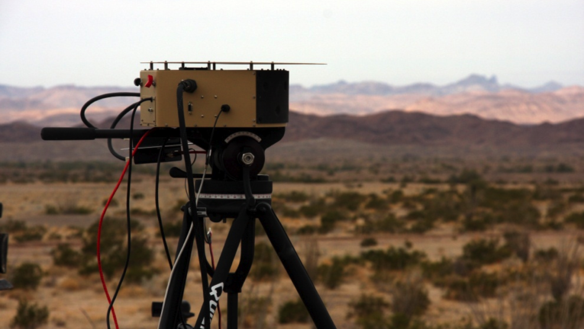
Officially, this technology is catchily named the Cognitive Technology Threat Detection System, but even DARPA (the guys making it) have taken to calling it Luke’s Binoculars. (Yes, that’s “Luke” as in “Luke Skywalker.”) It’s still in development, so right now the system doesn’t look anything like binoculars. It’s actually just a high-megapixel camera mounted on a tripod, capable of seeing UV and regular light up to 10 kilometers (6.8 mi) away, provided there’s nothing blocking the view.
But you don’t give something a Star Wars name without good reason. The system links directly into the brain through an EEG cap and detects threats based on variations in the soldier’s brainwaves. The idea is that our minds are able to perceive patterns before we’re consciously aware of them, so the system simply pulls the raw data straight from a soldier’s head and bypasses his thought processes completely. The brainwave patterns are fed into a computer, which then tells you “Yes, that’s a threat, shoot it.” All of this happens before the soldier would be able to personally analyze what he’s seeing, then come to a decision about whether or not to attack. The difference is measured in milliseconds, but that tiny change can make a huge difference in the field. The obvious challenge here is making sure the computer can, in fact, accurately discriminate between enemies and friendlies.
8UV Vision
In 2012, Dr. Miguel Nicolelis brought a hammer down on the glass box of everything we know to be true about the world and created a cyborg rat with an extra sensory organ—giving it the ability to see and feel ultraviolet light (UV). His team developed a neuroprosthesis consisting of two parts. The first is a UV sensor that’s attached to the rat’s head like a little hat. The second is a plug that wires directly into the rat’s brain. Specifically, it connects to the somatosensory cortex, the part of the brain responsible for processing tactile sensations.
When these two pieces are connected, the rat is suddenly able to “feel” the presence of UV light. It took about a month to train the rats to understand what the new sensation was, but after 30 days they were able to pinpoint a source of UV light a over 90 percent of the time. Even more incredible, the rats actually began changing their behavior to compensate for their new sense—they would stand on one side of the cage and sweep their head back and forth until they picked up on the UV, then move towards it.
Rat behavior is one thing, but humans are a whole different animal. Literally. However, we’re also an animal with our own somatosensory cortex, and Nicolelis sees this technology being tested on human subjects in the near future. For example, it could potentially allow military amputees to “feel” their prosthetic limb just like a real limb. But even more promising is the fact that the UV sensor is completely interchangeable, meaning you could put essentially any sensory device on the outside as long as the neural connection was there. And that has incredible military applications.
7Nuclear-Powered Insect Drones
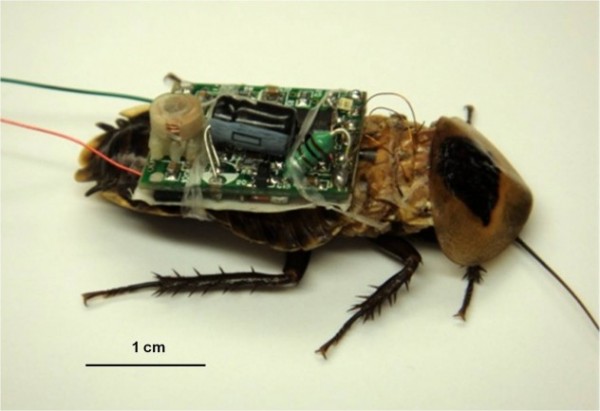
What do you get when you combine living insects, machinery, and nuclear power? If you said an army of mini-Mothras, you wouldn’t be too far off. We’ve covered insect drones in a previous list, but to recap, DARPA has been working on a project to implant electronic controls into beetle larvae. As the beetle matures, the electronic parts become enmeshed in its growing body, and it can be controlled wirelessly by stimulating its wing muscles.
And it works, there have been actual cyborg insects for years now. But the problem isn’t the technology, it’s finding a way to power it. An insect like a rhinoceros beetle can fly carrying around 30 percent of its weight—2.5 grams, give or take. That’s not a lot, and between the electronics and the battery, there isn’t much room left for anything useful, like a camera or a microphone. So what researchers are doing now is taking out the battery completely in favor of sprinkling radioactive isotopes onto something called a micro-piezoelectric generator.
The isotope, nickel-63, isn’t radioactive enough to put humans in danger, but it still emits plenty of beta particles. These particles push the piezoelectric generator back and forth, generating a few milliwatts of power with each stroke and powering the steering controls on the robobug. And since nickel-63 has a half-life of 12 years, the “battery” works for the insect’s whole life.
6Nanobot Doctors

In 2010, a military report was released containing some surprising statistics. Between 2001 and 2009, only 19 percent of evacuations from the Middle East were due to “battle-related injuries.” 56 percent were evacuated because of sickness. And that makes sense, even if it’s not a fact that makes it to the news very often. Historically speaking, most wartime casualties have always been caused by disease, not the enemy.
So DARPA began working on a solution—nanobots that live inside soldiers and can diagnose diseases. And once a disease has been detected, the nanobots will be able to actually treat it, curing the soldier before he or she even gets a sniffle. Known as “In Vivo Nanoplatforms,” work began on the diagnostic side in 2012 and transitioned into the treatment phase early in 2013—different types of nanobots are needed for each phase. The bots piggyback on a natural protein known as a lipoprotein, and monitor the soldier at the molecular level, preventing not only diseases, but chemical attacks, before they have a chance to harm the soldier.
5Intelligent Uniforms

When disease isn’t a factor, you’re left with a much more obvious downside to war—gunshot wounds. Another report that stemmed from the Iraq war was equally startling. A full quarter of the combat deaths between 2001 and 2011 could have been prevented if the soldier had received faster medical care. In other words, 2,700 people died somewhere between a rifle barrel and a hospital, and the military is hard at work on the problem. Not by building more hospitals, but by developing uniforms that sense a wound and transmit the information to a nearby medic.
And we’re talking full diagnostics. The clothing is made from cloth mesh with embedded sensors that will detect the location of a bullet, how deep the bullet went, and which, if any, vital organs were hit. Additional sensors that monitor blood and urine can detect any other type of damage, be it chemical, nuclear, or biological. The goal is to give this suit the power to immediately identify any physical attack on a soldier. When an attack occurs, that information is stored on a mini-computer in the uniform, which a medic can scan to immediately decide what kind of treatment is needed. The information is also sent to the nearest military headquarters, so commanders can keep track of their soldiers in real time.
4Weaponized Railguns
Railguns aren’t nearly as “sci-fi” as people seem to think. The first one was built during World War II, and they’ve popped up on the radar every now and then ever since. Heck, you can build one yourself with a disposable camera and a few minutes on Google. In a nutshell, railguns work by sending a current through two parallel rails. When a metal projectile is placed on the rails, it completes the circuit and creates an electromagnetic field. That field produces something called a Lorentz force, which shoves the projectile down the rails—fast.
Railguns can be incredibly powerful, but since they take so much electricity for each shot, they haven’t really been feasible as an actual weapon. That hasn’t stopped the Navy from building one capable of firing a shot at over seven times the speed of sound. It can shoot targets up to 160 kilometers (100 mi) away, and hits with a force equivalent to “32 times the force of a car crash at 100 mph.” Although the Navy claims that the railgun is fully weaponized, they’re still struggling with the power problem. Right now, the general plan is to use the railgun on warships and power it with a bank of rechargeable batteries. They haven’t even been able to test it with real projectiles yet, since they would probably end up leveling a town miles away, so instead they’ve been firing the most un-aerodynamic objects they can find. And it still looks awesome.
3HELLADS
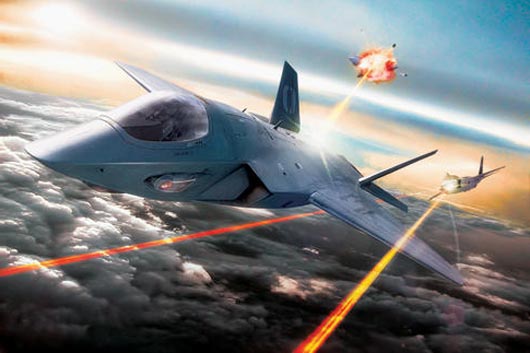
The High Energy Liquid Laser Area Defense System, or HELLADS, is the combination of a dozen different technologies for one awesome purpose: laser weapons mounted on fighter jets. Managed by DARPA, the HELLADS program aims to produce a 150-kilowatt laser that’s light enough to fit aboard a relatively small plane like a B-1 Lancer, which means it has to be roughly 10 times lighter than any similarly powered current laser. In the past, a megawatt (1,000 kW) laser was mounted onto a Boeing 747, but this time around they’re looking for something slightly more maneuverable.
To do that, DARPA has been working on developing a series of smaller solid-state lasers that can be combined to create a single, more powerful beam—a goal which they’ve already reached. The project is currently in Phase 3, which involves controlled testing, and they’re planning to test it on a surface-to-air missile sometime in early 2014.
2Geckskin Suits

When a gecko climbs a wall, it’s held in place by tiny hairs that exert a van der Waals force on the wall’s surface—the gecko’s feet are actually attracted to the wall at the molecular level. Millions of microscopic hairs line the bottom of a gecko’s feet, and at the ends of those hairs are even smaller hair-like pieces called spatulae, which create an electric attraction to the molecules in whatever wall they’re climbing. The force is so strong that a gecko can cling upside down to a pane of glass by one finger.
And now, we can too. Based on years of studying geckos, a team of researchers at the University of Massachusettes developed Geckskin, an adhesive fabric that uses the same van der Waals force to stick to a surface. Geckskin is strong enough to hold 317 kilograms (700 lbs) on a strip about the size of an index card.
What does that have to do with war? As it turns out, it was none other than DARPA who commissioned the research in the first place, through their ambiguously named Z-Man program, which aims to create suits that allow soldiers to scale walls like Spider-man.
1War Forecasting

It’s one thing to be able to react to war with a range of weapons and technologies, but what if you could predict when wars were going to occur before a single shot was fired? Lockheed Martin has developed a system that does exactly that—and it’s already being used by the US government to forecast wars, like a meteorologist predicting the weather (though hopefully with more accuracy).
Since 2001, the Worldwide Integrated Crisis Early Warning System (W-ICEWS) has been collecting over 30 million pieces of data from news reports around the world. Using that data, coupled with prior knowledge of political unrest that has previously occurred, they’ve put together an algorithm called iTRACE that looks for warning signs in the world’s media. As they put it, iTRACE converts “news reports into structured indices that reflect the character and intensity of interactions between key leaders, organizations, and countries—who is doing what to whom, when, where, and how around the world.” In other words, the system finds patterns in the world news, and decides if those patterns point to war. Let’s just hope nobody gets the bright idea to connect iTRACE directly to our nuclear arsenal. You know, to save time.
